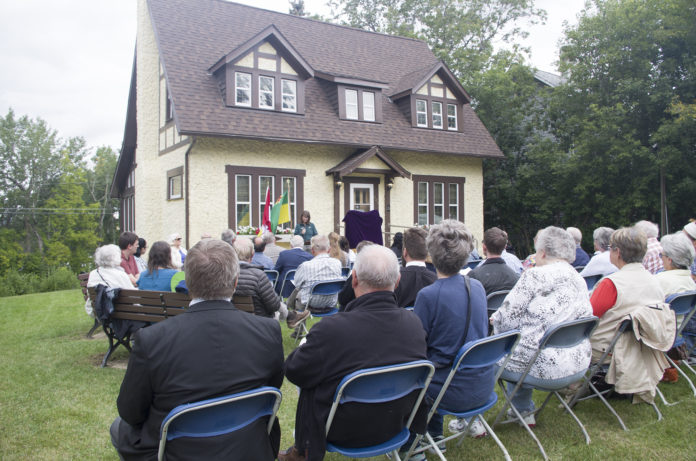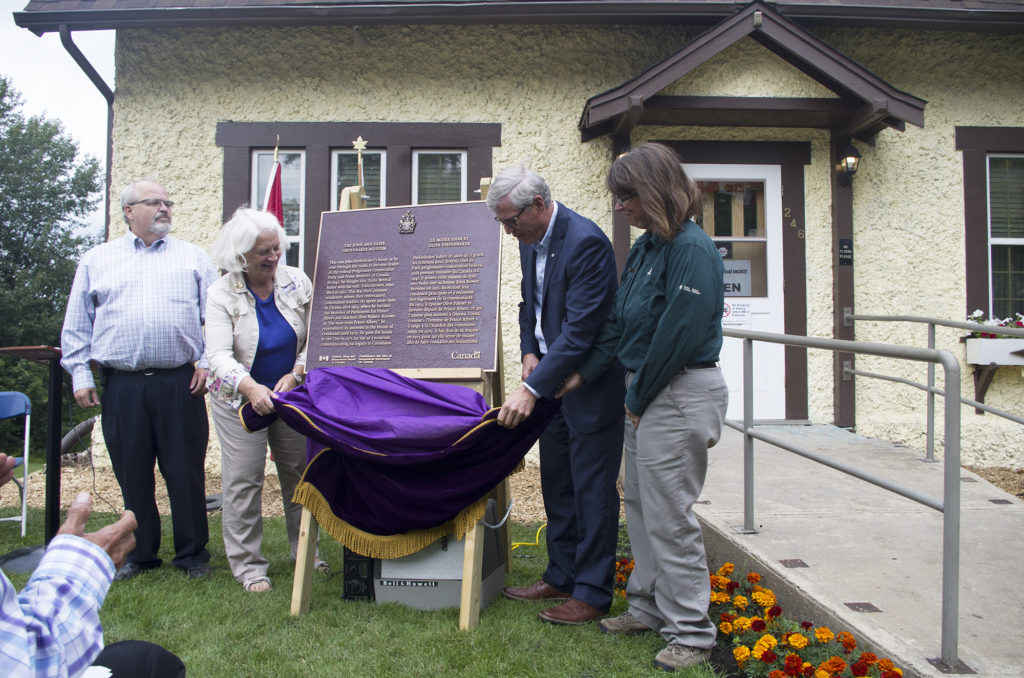
The John and Oliver Diefenbaker Museum has always had a special place in Prince Albert history, and now it has a special place in Canadian history too.
Dignitaries, guests and local residents crowded the museum’s front lawn for the unveiling of a plaque honouring the site’s national and historical significance.
For those in attendance, like Prince Albert Historical Society president Connie Gerwing, the ceremony was well worth the wait.
“It’s taken a long, long time,” she chuckled following the unveiling. “It was long before I was involved that (the society) started to get this designated a national historic site. Historical things seem to run in historical times, so it’s long, but I’m really pleased.”
Located at 246, 19th Street West, the former home of John Diefenbaker is an excellent example of Tudor Revival architecture. The home retains the safe layout as it did when Diefenbaker lived here, with the exception of the kitchen. Today it stands as a testament to the life and political career of one of Prince Albert’s most famous residents.
Gerwing said the house is still in great shape, other than the odd leak, but considering it was built over a century ago, it’s in great shape.
“It’s not bad for 1911,” she said.

However, this day wasn’t just about the house, it was about the man himself. For many in attendance, John Diefenbaker was more than his political achievements. The ‘Man from Prince Albert’ as he was called was the first Canadian Prime Minister who was of neither English nor French descent, and his Progressive Conservative Party’s landslide victory in 1957 stands as the largest majority in federal political history. But he was also a close friend, and someone who made his mark in Prince Albert long before he did so on the national stage.
Indigenous knowledge keeper and elder Leo Omani, who delivered the opening prayer at Friday’s ceremony, remembers Diefenbaker as the Prince Albert lawyer who fought to keep his aunt’s family together. When this aunt had her third child, there was some danger that all three would be taken away. Omani’s father Joe enlisted Diefenbaker’s help in fighting the case in court. Diefenbaker won, and the family stayed together.
“It was very touching for us, to know Mr. Diefenbaker. He was a lawyer and had to intervene so we would keep our own family together,” Omani said afterwards. “He didn’t have to do it, but he did, so you can tell what kind of person he was.”
Omani added that those convictions didn’t stop when Diefenbaker became Prime Minister. During a short speech, he noted that ‘Dief the Chief’ fought for Indigenous rights on the national stage just like he did at home, by bringing in the Bill of Rights which gave First Nations people the right to vote.
“That speaks highly of him and the type of person he was,” Omani said. “He was willing to take personal risk without worrying about his popularity. If it was something he believed was right … he did it.”
Diefenbaker and his first wife Edna purchased the house that now bares his name in 1947. It was their primary residence until Edna died in 1951. Diefenbaker still lived their with his second wife, Olive, but spent more and more time in Ottawa after 1953.
Still, historians like Bill Waiser, the Saskatchewan representative on the Historic Sites and Monuments Board of Canada (HSMBC), said there’s no doubt this place is of national importance.
“It’s very fitting that this home in Prince Albert is being recognized this way because it is a place of national significance and it really connects Prince Albert with Diefenbaker and his larger importance to Canada,” Waiser said.
“I think he’d be extremely proud and delighted (about the honour),” Waiser added. “One of Diefenbaker’s favourite lines was ‘everybody’s against me but the people’ and this is like the people’s home. This is his legacy. The people of Prince Albert, and wider Canada, come here and learn something about this man and his second wife and his political career before he became Prime Minister, so he would be very delighted by this.”
John Diefenbaker was the MP for Prince Albert until his death in 1979.
The HSMBC was first created in 1919, and has since played a leading role in identifying and commemorating nationally significant persons, places and events in Canada.

